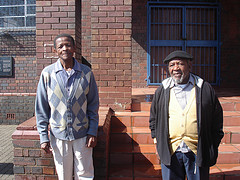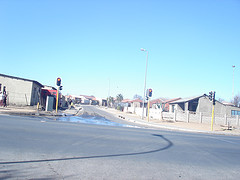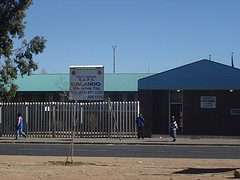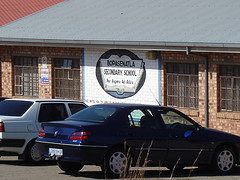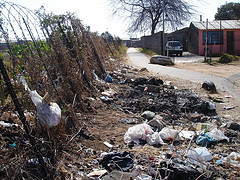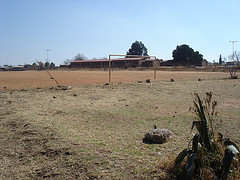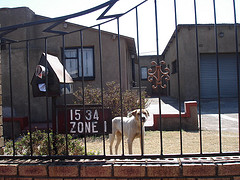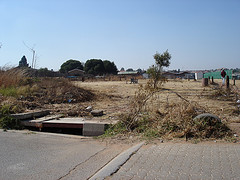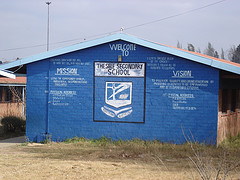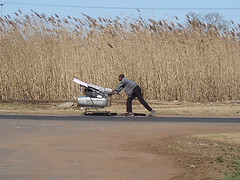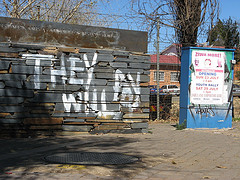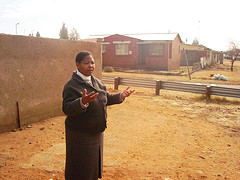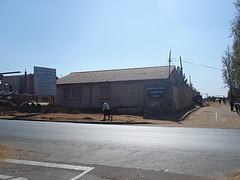PAC led 1960 Poisitve Action Campaign Route from Orlando East
Date: 17 July 2007
Route Guide: John Gaanakgomo (PAC member)
Documenter: Ismail Farouk
Facilitator: Ali Hlongwane, (curator HPMM)
Observers: John Mahapa and Babak Fakhamzadeh
John Gaanakgomo was the first Chairman of the PAC in Orlando East. His political career began in the ANC Youth league but because of ideological differences with the organisation, he along with other members of similar thought, broke away from the ANC to form the PAC. Gaanakgomo elaborates, " We deviated from the ANC because of the issues around land and Africaness. The Freedom Charter states, âÂÂThe People Shall GovernâÂÂ. But who are the People? Africa is for Africans!" It was because of the contrary issue of Africanism that the PAC was formed at the Orland East Community Center in 1959.
On the morning of 21 March 1960. Members of the PAC were strategically positioned on street corners in Orlando East to intercept men walking to the train station on they way to work. Passing men were encouraged not to go to work but rather to hand themselves over for arrest.
Figure: John Gaanakgomo waited here on the 21st March 1960. He targeted all males on their way to work asking them to present themselves for arrest at the police station.
Gaanakgomo was positioned near Mlamlankunzi Station which is located in close proximately to the Orlando Police Station. He remembers addressing men asking them to proceed to the Police Station. He received mixed reactions to his request, "Some men were surprised, others thought we were mad for our actions. Some joined willingly. Others were forced to."
As the PAC members walked towards the police station on Mooki Street they sang their songs and were greeted by students from Orlando High School. Some students joined the march.
The idea was to flood the jails as a protest action against reference books.
As they neared the police station, the men were warned about special police who were deployed to disrupt the march. So the marching men dispersed and took back roads to avoid special police. Soon they reached the Orlando Police Station where the waiting men assembled under the shade of a blue gum tree.
Gaanakgomo remembers waiting outside for most of the day. More men arrived in drips and drabs. Eventually, the police arrested the core members of the organization only. But Gaanakgomo and his group insisted on being arrested with their leaders and so a short while later all of the waiting men were arrested. John Gaanakgomo was detained for several months later.
Route Guide: John Gaanakgomo (PAC member)
Documenter: Ismail Farouk
Facilitator: Ali Hlongwane, (curator HPMM)
Observers: John Mahapa and Babak Fakhamzadeh
John Gaanakgomo was the first Chairman of the PAC in Orlando East. His political career began in the ANC Youth league but because of ideological differences with the organisation, he along with other members of similar thought, broke away from the ANC to form the PAC. Gaanakgomo elaborates, " We deviated from the ANC because of the issues around land and Africaness. The Freedom Charter states, âÂÂThe People Shall GovernâÂÂ. But who are the People? Africa is for Africans!" It was because of the contrary issue of Africanism that the PAC was formed at the Orland East Community Center in 1959.
On the morning of 21 March 1960. Members of the PAC were strategically positioned on street corners in Orlando East to intercept men walking to the train station on they way to work. Passing men were encouraged not to go to work but rather to hand themselves over for arrest.
Figure: John Gaanakgomo waited here on the 21st March 1960. He targeted all males on their way to work asking them to present themselves for arrest at the police station.
Gaanakgomo was positioned near Mlamlankunzi Station which is located in close proximately to the Orlando Police Station. He remembers addressing men asking them to proceed to the Police Station. He received mixed reactions to his request, "Some men were surprised, others thought we were mad for our actions. Some joined willingly. Others were forced to."
As the PAC members walked towards the police station on Mooki Street they sang their songs and were greeted by students from Orlando High School. Some students joined the march.
The idea was to flood the jails as a protest action against reference books.
As they neared the police station, the men were warned about special police who were deployed to disrupt the march. So the marching men dispersed and took back roads to avoid special police. Soon they reached the Orlando Police Station where the waiting men assembled under the shade of a blue gum tree.
Gaanakgomo remembers waiting outside for most of the day. More men arrived in drips and drabs. Eventually, the police arrested the core members of the organization only. But Gaanakgomo and his group insisted on being arrested with their leaders and so a short while later all of the waiting men were arrested. John Gaanakgomo was detained for several months later.
Labels: Other Routes, PAC, PAC Route, Process, The Routes
